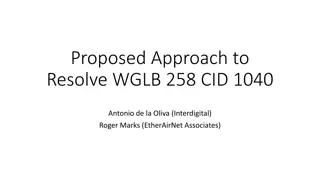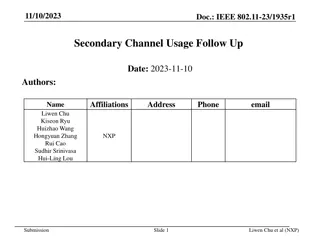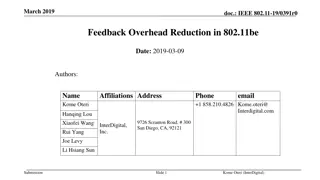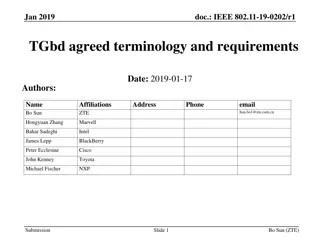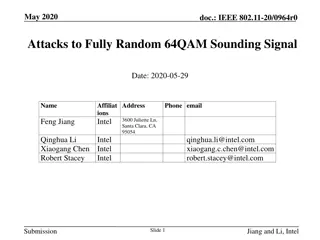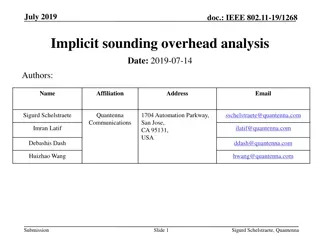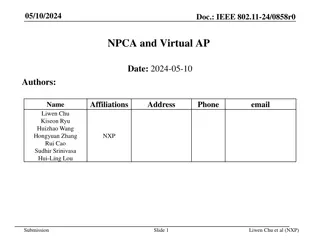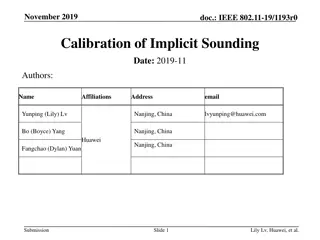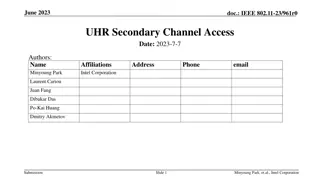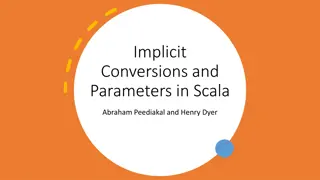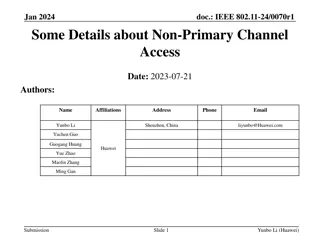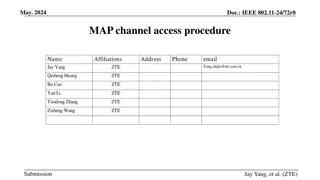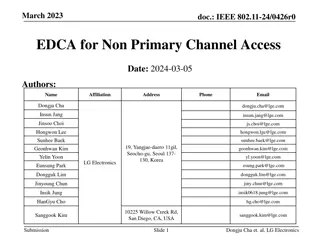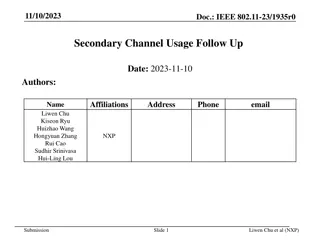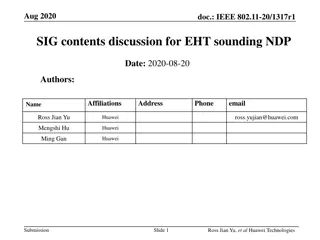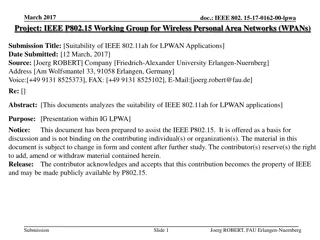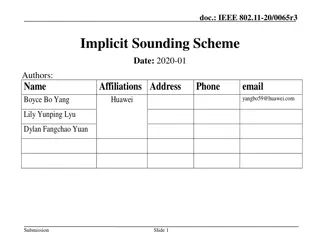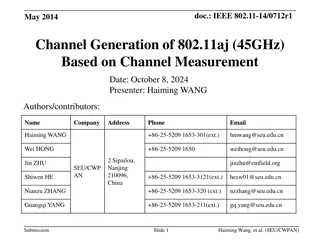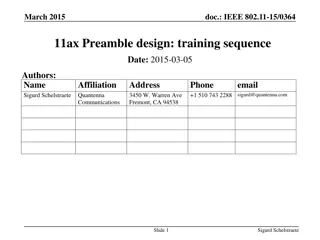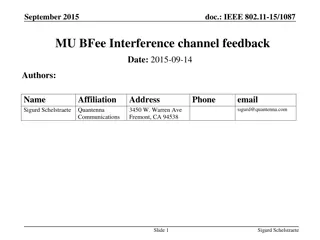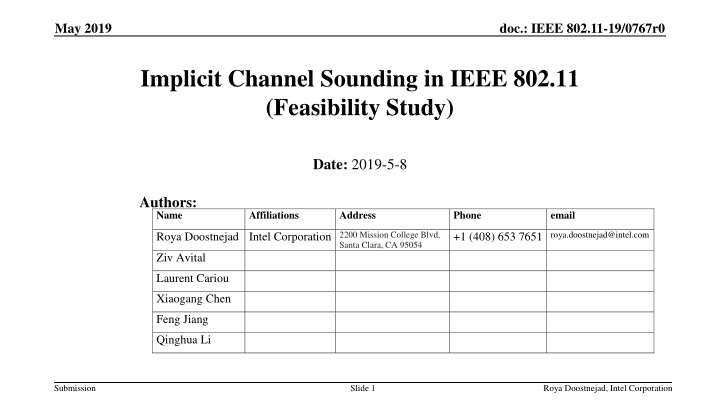
Implicit Channel Sounding in IEEE 802.11
Explore the feasibility of implicit channel sounding in IEEE 802.11 protocol, analyzing challenges faced with explicit beamforming feedback in dense networks. Discover the benefits of lower network overhead and reduced latency with implicit channel sounding.
Download Presentation

Please find below an Image/Link to download the presentation.
The content on the website is provided AS IS for your information and personal use only. It may not be sold, licensed, or shared on other websites without obtaining consent from the author. If you encounter any issues during the download, it is possible that the publisher has removed the file from their server.
You are allowed to download the files provided on this website for personal or commercial use, subject to the condition that they are used lawfully. All files are the property of their respective owners.
The content on the website is provided AS IS for your information and personal use only. It may not be sold, licensed, or shared on other websites without obtaining consent from the author.
E N D
Presentation Transcript
May 2019 doc.: IEEE 802.11-19/0767r0 Implicit Channel Sounding in IEEE 802.11 (Feasibility Study) Date: 2019-5-8 Authors: Name Affiliations Address Phone email Roya Doostnejad Intel Corporation 2200 Mission College Blvd, +1 (408) 653 7651 roya.doostnejad@intel.com Santa Clara, CA 95054 Ziv Avital Laurent Cariou Xiaogang Chen Feng Jiang Qinghua Li Submission Slide 1 Roya Doostnejad, Intel Corporation
May 2019 doc.: IEEE 802.11-19/0767r0 Introduction Explicit BF Feedback/ IEEE 802.11ax Challenges: o Network overhead as a result of BF feedback reports esp in case of AP with larger number of antennas, dense network with large number of STAs, and Multi-AP o Quantization/Compression impact o Channel aging/large delays between the channel estimation and the MU-MIMO data transmission time Implicit Channel Sounding may result: o Lower network overhead/ Less Latency as there is no BF feedback transmission. o No quantization/compression impact as BF weights are calculated directly from channel. o Efficient DL Multiuser (MU) BF, MU scheduling, power control Submission Roya Doostnejad, Intel Corporation Slide 2
May 2019 doc.: IEEE 802.11-19/0767r0 Introduction Implicit BF Feedback: Relying on TDD transmission and channel reciprocity Uplink pilot/NDP transmission from users to enable uplink channel sounding o TDD: UL and DL channels have identical impulse response in the same coherence interval o The baseband-to-RF and RF-to-baseband conversion chains need not be reciprocal. As a result, the effective downlink baseband channel is not equal to the effective uplink baseband channel unless this mismatch is explicitly compensated through Calibration. RF Reciprocity Calibration is required. Newer developed Local AP Calibration may be applied where the device is not required to be involved in calibration process[1, 2]. o In this contribution, we analyze the feasibility of Local AP Calibration Submission Roya Doostnejad, Intel Corporation Slide 3
May 2019 doc.: IEEE 802.11-19/0767r0 RF Calibration Concept AP-STA Calibration: The channel between ????/?? and ???? is: ij= ?? ?? , ji= ?? ?? where ?? ??, ?? ?? o is propagation channel and assumed to be the same in DL and UL o ??and?? are receiver and transmitter at AP/device-i. Calibration Factor at ???: ???? ?? ??/?? ??/?? ?? ?= ij/ ji= ?? o ij has to be measured at ???? and feedback to ???. o This has to be repeated for each element Channel is measured in UL. Calibration factors (k) are applied on Channel Matrix and then BF vector is calculated. ???? Submission Roya Doostnejad, Intel Corporation Slide 4
May 2019 doc.: IEEE 802.11-19/0767r0 Local AP Calibration It requires only the AP to be involved in the calibration (internal) o There is no need for exchanging reference signals and channel information with other devices. o This works based on the fact that in BF/Linear precoding, it is sufficient for antennas to have a relatively accurate channel estimation. As long as each antenna s CSI estimation deviates from the real CSI by the same multiplicative factor, BF will still result in the same beam pattern. Relative calibration: Each antenna is calibrated with respect to a reference antenna. o In Figure below, ????,???? are antenna elements of the same AP. The calibration factors for antennas ?,? are: ?? ? ?? ? =??/?? ??/?? ??/?? , ?? ?=??/?? ???? ??/??, ???? ?? ?= ?? ??/?? ?? ?? ?? If?? ?= ?1=1, ??= ?? ?=??/?? = ?? ?? ??/?? ???? ?? is the relative calibration factor for antenna element ?. o Submission Roya Doostnejad, Intel Corporation Slide 5
May 2019 doc.: IEEE 802.11-19/0767r0 Local AP Calibration ARGOS:Select a reference antenna (call ????) o Sequentially transmit calibration pilots, one pilot from each element. o Calibrate ???? with respect to (reference) ????, for each j ? o Simpler scheme but the accuracy of calibration can be a function of relative location of elements to the reference element [1]. Least Squares (LS): The pilot signals are transmitted to and from all elements sequentially [2]. The received signal at elements ?,? are respectively: ???= ?? ??+ ?? ???= ?? ??+ ?? This can be written as: [??? ?? ??]. + [?? ??] = [?? ??].???+ [?? ???] =[?? ?? ??]` ??= ?? ?? , ?? = ??/?? , (Noiseless Observation: ?? ???= ?? ???) 2 LS Cost function: i,jcj Yji ci Yij Submission Roya Doostnejad, Intel Corporation Slide 6
May 2019 doc.: IEEE 802.11-19/0767r0 Local AP Calibration To exclude the trivial all-zero solution , we assume ?1 0 ,?1 = 1. By defining: 2 for ? = ? ??,?= ??? ? ?? ? ?? ? for ? ? ? Then relative calibration factors are: ? = ?2, ,??? o where a1 is the first column of A: ? = a1|?1 1?1?a1?1 ? = ?1??1 This requires inversion of a matrix with dimensions equal to the cardinality of size of the network. Since the calculation is done in central processor/software, the computational complexity of calculation of calibration factors is not a concern. Submission Roya Doostnejad, Intel Corporation Slide 7
May 2019 doc.: IEEE 802.11-19/0767r0 Simulations Signal mixers and amplifiers are the main sources of hardware asymmetry. The random phases introduced by the signal mixers are uniformly distributed in , Amplitudes are independent variables uniformly distributed in [1- ,1+ ] with chosen such that the standard deviation of the squared magnitude is 0.1. Phase of RF components is changed linearly over frequency bins Generate Calibration pilots e.g. Generate Zadoff Chu (ZC) sequences in frequency Repetition and Combining: Calibration ref signals may be repeated over several symbols to improve the calibration accuracy. Submission Roya Doostnejad, Intel Corporation Slide 8
May 2019 doc.: IEEE 802.11-19/0767r0 Simulation Results: LS vs ARGO LS improves Calibration accuracy compared to ARGO scheme. The residual phase/amplitude calibration error at AP is less than 4 degrees/ -22 dB. For SNR> 20 ??, LS calibration error falls less than 3 deg/1 deg (one repetition/4 repetition) (F is Calibration Factor) Submission Roya Doostnejad, Intel Corporation Slide 9
May 2019 doc.: IEEE 802.11-19/0767r0 Simulation Results/Impact of Calibration Error on MU BF Submission Roya Doostnejad, Intel Corporation Slide 10
May 2019 doc.: IEEE 802.11-19/0767r0 Simulations IEEE Channel model D (BW=80 MHz) AP with 4/8 Tx antennas transmitting at 24 dBm Number of STAs: 4 and 6 Single data steam to each STA Noise floor of -89.9 dBm STA with 2 Receive antennas Transmitter: o Multiuser ZF BF Receiver: MMSE Path Loss Model: Free Space: Ploss= 46.77+20log10(d) o D=10:10:80 m Submission Roya Doostnejad, Intel Corporation Slide 11
May 2019 doc.: IEEE 802.11-19/0767r0 Impact of Reciprocity Error at the Device in MU MIMO BF Reciprocity Phase Error at the device has no impact on MU MIMO Transmit BF [2] Reciprocity Amplitude error at the device has a minor impact. Conclusion: RF Calibration is only applied at AP. No need for Calibration at the device. Example: AP (8-antennas) and 4 STAs (two antennas) AP: No Reciprocity error STAs: Phase Errors of (-70, 70) deg No Impact STAs: Amplitude Error (Uniform distribution (0.5,1.5) ) Less than 0.5 dB impact Amp/Phase Error is the difference in Amp/Phase between transmitter and receiver in each Antenna (Reciprocity error) Submission Roya Doostnejad, Intel Corporation Slide 12
May 2019 doc.: IEEE 802.11-19/0767r0 Impact of Residual Calibration Error at AP Assumptions: LS Calibration is performed at AP, no calibration at STA The residual phase calibration error at AP is less than 4 deg To observe the worst case scenarios following examples are simulated: o STA: Reciprocity Amp/angle Error Amplitude Error (Uniform distribution (0.5,1.5) ), Phase Errors of (-60, 60) deg o AP: Residual Amplitude error: ??????? ???? [ 0.9, 1.1] AP: Residual phase error: ? =[-3 3 -3 3 -3 3 -3 3] (deg) AP: Residual phase error: ? =[-6 6 -6 6 -6 6 -6 6] (deg) Submission Roya Doostnejad, Intel Corporation Slide 13
May 2019 doc.: IEEE 802.11-19/0767r0 Simulation Results Impact of residual calibration error at AP on MU BF performance o Residual phase calibration error is for each antenna (the difference between receive and transmit RF chains). Submission Roya Doostnejad, Intel Corporation Slide 14
May 2019 doc.: IEEE 802.11-19/0767r0 PER Results IEEE Channel model D (BW=20 MHz) AP with 4/8 Tx antennas transmitting Number of STAs (2 receive antennas) : 2 / Single data steam to each STA Noise floor of -89.9 dBm Receiver: MMSE Submission Roya Doostnejad, Intel Corporation Slide 15
May 2019 doc.: IEEE 802.11-19/0767r0 Conclusion Local AP Calibration is discussed LS and ARGO schemes are evaluated, LS provides improvement in calibration accuracy. LS calibration at AP may result less than 4 deg residual error at each element. RF calibration is not required at the device. The impact of calibration error on MU MIMO BF is evaluated. For higher number of users in DL MU MIMO BF, AP calibration error has to be maintained in lower range (less than 4 deg). Multi-AP: o In Coordinated Multi-AP schemes when data is transmitted by single-AP, calibration is performed in each single AP. o In joint Processing/ BF schemes, calibration has to be performed across multi-AP. RF calibration can be performed locally at the AP to facilitate implicit sounding. Submission Roya Doostnejad, Intel Corporation Slide 16
May 2019 doc.: IEEE 802.11-19/0767r0 References [1]: Shepard et all, Argos: practical many-antenna base stations, in Proceedings of the 18th Annual International Conference on Mobile Computing and Networking, Mobicom 12 [2]: Rogalin et all, Hardware-Impairment Compensation for Enabling Distributed Large-Scale MIMO, ITA Workshop, Feb 2013. Submission Roya Doostnejad, Intel Corporation Slide 17


